Portland Landscaping Expert Discusses Overcoming Soggy Lawns
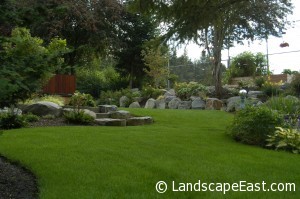 Sodden lawns are not uncommon in Portland landscaping. Portland’s geology features layers of clay and undulating hills—two problematic features for lawn lovers. Clay-laden soil retains water; it creates a dense top layer (a “hardpan”), which is difficult to break through when planting new shrubs and trees. And Portland’s hilly topography naturally creates dells where water gathers. The Portland landscape dooms many lawns to suffer sogginess.
Sodden lawns are not uncommon in Portland landscaping. Portland’s geology features layers of clay and undulating hills—two problematic features for lawn lovers. Clay-laden soil retains water; it creates a dense top layer (a “hardpan”), which is difficult to break through when planting new shrubs and trees. And Portland’s hilly topography naturally creates dells where water gathers. The Portland landscape dooms many lawns to suffer sogginess.
Perpetually drenched lawns are unlikely to thrive, as grass roots rot in too-wet environments. Over time, the desired turf grass may lose ground to moss and less desirable foreign grasses that are better suited to moisture. Soggy lawns tend to pull down property value, as uneven grass decreases curb appeal. And there are day-to-day hassles of a soggy lawn—more mud tracked in by pets and kids, for one thing. What is the point of having a lawn if you can’t enjoy it due to lingering puddles? But this enjoyment factor is nothing compared to the worst possibility of all—damage to your home’s siding or moisture under your house due to excessive standing water.
As Portland landscapers, we’ve dried out many soggy lawns. In this white paper, we explore the Portland soggy lawn problem. To begin, we discuss the science behind how soil moisture levels impact plants (including lawn grasses). Next, we list common causes behind soaked turfs. Finally, we provide answers for Portlanders whose lawns are just too wet. With expertise and effort, it is possible to heal a lawn struggling under excess dampness.
Root Structure: The Biology of Plant Survival in Wet or Dry Soil
A continually soaked yard suffocates lawn roots, leading to rot. Just like humans, plants cannot survive without air. If a patch of land is constantly wet, water fills the crevices within soil, and the roots cannot access oxygen. Too-wet conditions limit plant growth. Those species that do survive in a soggy setting are more susceptible to disease.
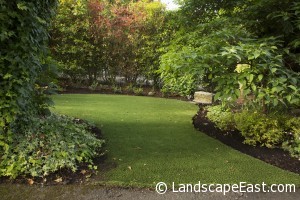 With that said, certain plants have evolved to flourish in wet conditions. Mangrove trees, for instance, have developed special above-water structures (pneumatophores) that allow them to get enough oxygen even when their roots are submerged. On the other hand, some inland species are generalists that can grow almost anywhere. The red maple is a good example. It thrives across the Northeast because it adapts its root structure to surrounding circumstances. In wet areas, red maples send out more lateral roots to absorb surface water. The same species will grow more taproots to access deep water in dry conditions.
With that said, certain plants have evolved to flourish in wet conditions. Mangrove trees, for instance, have developed special above-water structures (pneumatophores) that allow them to get enough oxygen even when their roots are submerged. On the other hand, some inland species are generalists that can grow almost anywhere. The red maple is a good example. It thrives across the Northeast because it adapts its root structure to surrounding circumstances. In wet areas, red maples send out more lateral roots to absorb surface water. The same species will grow more taproots to access deep water in dry conditions.
In the northern states, we rely on a few species of cool season turfgrasses for lawns. These grasses have primary and secondary root systems. The primary roots (AKA seminal roots) are adapted to absorb water and nutrients as the grass is established; later on, secondary roots (AKA adventitious roots) take over the majority of absorption. Grass roots grow to a depth of two to six inches; they cannot grow deep taproots to absorb water as a red maple can. Nor do grasses have adaptations to allow them to survive excess moisture; if the ground is waterlogged for long periods, grass will begin to die as its roots suffocate.
Now that we have a biological perspective on why wet lawns fail, let’s take a look at the reasons why a yard becomes be soggy.
Common Causes of Soggy Portland Lawns
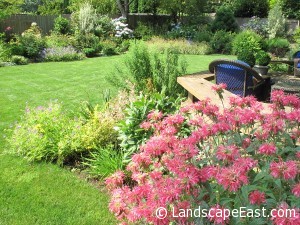 There is rarely a single root cause of any landscaping problem. More often, a soggy lawn stems from several problematic conditions. Below we list the main contributors to a drenched lawn:
There is rarely a single root cause of any landscaping problem. More often, a soggy lawn stems from several problematic conditions. Below we list the main contributors to a drenched lawn:
Topsoil Removal. Shoddy contractors may fail to consider soil amendment before installing turf. They may do little beyond laying sod on hard compacted soil and gravel left when the house was built. It is very common for the site prep excavator to strip the layer of top soil off the building site to get a good base for the house foundation, driveways, and paths. Why is this problematic? Because without further aeration and preparation, lawn roots will have a very hard time extending through clay-heavy hardpan.
Lack of Water Absorption. In addition to restricting drainage, a crusty hardpan makes it difficult for lawn roots to absorb water. The water will tend to pool or quickly run off, resulting in shallow lawn roots that will quickly dry out and die in the summer heat. Without building up the soil in some way, Portland lawns may not be able to absorb enough water for healthy growth.
Problematic Slopes. Real estate in this town varies widely. Flatter areas—such as the Foster-Powell neighborhood—may sustain stronger grass growth, as drainage is reliable. However, drainage problems are common in the West Hills; there, rolling knolls create pockets where water pools. If you’re at the bottom of a hill, neighboring slopes direct water to your yard. When water has nowhere to go, a lingering pool is inevitable.
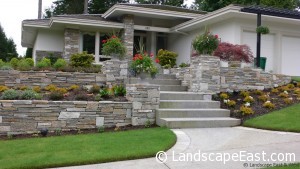 Natural Springs and High Water Tables. Certain Portland communities have natural springs, where water bubbles up from the earth. The West Linn area—particularly Hidden Springs—suffers from this groundwater issue. If water seeps up into your yard, it may be too wet for lawn growth.
Natural Springs and High Water Tables. Certain Portland communities have natural springs, where water bubbles up from the earth. The West Linn area—particularly Hidden Springs—suffers from this groundwater issue. If water seeps up into your yard, it may be too wet for lawn growth.
Soil Compaction. Healthy soil has plenty of tiny cavities where water and nutrients can flow. This is referred to as soil aggregation. Foot traffic presses down on soil, crushing the tiny soil tunnels and limiting plant growth. As such, even yards with decent soil can face difficulty growing a lush lawn due to compaction from pets, kids, machinery, and general perambulation.
Too Little Sunlight. Many grasses require consistent sunlight to thrive. If grass isn’t receiving enough light, it creates long, stringy stems and leaves as it endeavors to absorb as much light as possible. This process requires lots of carbohydrates and, as the grass shunts more energy to carbohydrate production, its overall health often suffers. Too little sunlight has the additional effect of minimizing evaporation, so that wet areas stay wet longer. The biggest contributor to shady lawns is tree cover.
Roof runoff. A roof sheds massive amounts of water in Portland’s downpours. If all roof water is directed into your lawn, you will likely see pooling. Gutters and poorly designed or clogged French drains can direct roof runoff onto a lawn, flooding the area and drowning roots.
Uneven grading. Water runs downhill—even very shallow slopes and minor elevation changes can direct water flow. An uneven lawn will have low spots where water will inevitably collect. This makes it difficult to grow a consistent lawn, as different depths will create different growing conditions. Even grading is important for lawn health.
Poorly designed landscaping. Inexperienced landscapers may not appreciate the importance of drainage in Portland yards. They may unwittingly direct water to the lawn, strangling its growth.
Understanding the cause of any problem is half the battle in solving it. Now let’s take a look at how to fix a soggy lawn.
Landscaping Solutions for Soggy Portland Lawns
1. Locate the Water Source. Evaluate where the water is coming from and how to mitigate it. Observation is an important step in solving lawn drainage problems. Once you understand the water’s flow, you can move on to redirecting it. Sometimes it is very difficult to determine the source of the water. A geotechnical engineer can be very helpful in identifying the water source that is impacting your property.
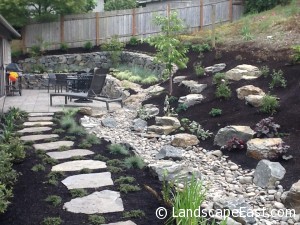 2. Create a Path for Drainage. This step will depend on where the water is pooling. If it is pooling in the middle, you will need some method of pushing water to the lawn’s periphery. For instance, you could add soil to the center. On the other hand, if the water pools only on one side of the property, a long French drain leading to a rain garden would likely work well.
2. Create a Path for Drainage. This step will depend on where the water is pooling. If it is pooling in the middle, you will need some method of pushing water to the lawn’s periphery. For instance, you could add soil to the center. On the other hand, if the water pools only on one side of the property, a long French drain leading to a rain garden would likely work well.
Scan your yard during a rainstorm and ask yourself, where can the water go? Does the water require a retained bed where it can collect and drain? Or will a French drain best draw away water to a good drainage area? For large stretches of lawn, it is often best to install a multi-flow system, essentially multiple French drains dug deeper into the earth. Or you may choose to add a dry creek bed to gather and drain water.
One thing to keep in mind is that French drains are not permanent. Eventually, they become clogged with sediment and will need to be redone.
3. Prepare the Soil. If your too-wet lawn is nearly bald, it may be best to till it and start over by amending the soil. Amending soil can greatly improve drainage by offsetting Portland’s clay-heavy soils. Gravel, sand or a mixture of both can open soil spaces and allow better drainage. Compost is another good addition to lawn soil; it helps soil retain nutrients. Overall, the goal is to prevent the formation of a surface hardpan by layering in materials that water can more easily move through.
It’s important to note that each site will have its own unique ideal soil formula. Additionally, you will need to adjust the tilling depth according to location.
4. Consider the Slope. Rainfall alone will rarely cause flooding; however, if your home is at the bottom of a hill, your neighbor’s yard may deposit a torrent to your door. In that case, it may be necessary to build a retaining wall to prevent further erosion and properly drain water away from your home.
5. Aerate. Sod growing over dense soil can benefit from aeration. Aeration refers to the process of using mechanized equipment to either puncture the soil with spikes (spike aeration) or remove approximately 1″ by 2″ cores of soil from the ground (core aeration). This creates pathways where water can flow down to roots. Aeration may be overlooked when trying to restore a lawn, but it is often vital for grass health. Soil aeration may be enough to reduce compaction and prevent puddling in minor cases.
Really, it is best to aerate every lawn every two or three years. In this time, lawns grow a thick layer of roots, which sheds water like roof thatching. This is problematic for the same reason as clay; it prevents water and nutrients from reaching down throughout the root zone. Moreover, heavy thatching promotes pest growth.
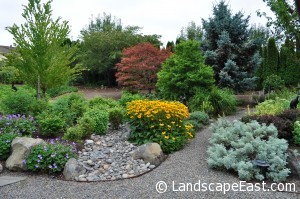 6. Add a Rain Garden. Rain gardens are landscaping features designed to accept, retain, and slowly drain water. Multi-flow drainage systems, installed under bigger lawns, often feature rain gardens in lawn valleys. By taking out a soggy, problematic lawn and adding a rain garden, you create a perfect place for water to drain. There are many additional reasons to add rain gardens; for one thing, they help purify run-off water.
6. Add a Rain Garden. Rain gardens are landscaping features designed to accept, retain, and slowly drain water. Multi-flow drainage systems, installed under bigger lawns, often feature rain gardens in lawn valleys. By taking out a soggy, problematic lawn and adding a rain garden, you create a perfect place for water to drain. There are many additional reasons to add rain gardens; for one thing, they help purify run-off water.
7. Select Seed and Sod Carefully. Most new sod varieties are sun mix, which if installed in a sunny area will do quite well. However, if your area is shady, the sod will thin out very quickly leaving the area very muddy when it rains. On the other hand, fine fescue prefers shade but requires well-drained soil. When laying a new lawn or reseeding an old one, it’s crucial to select a grass mixture that will do well where you place it. Less experienced landscapers may sow a sun sod mix where a shade mix should go. A mixture of fescue and ryegrass tends to do well in shady Portland areas. Ryegrass is well suited to wet spots; it can also withstand foot traffic.
8. Opt for synthetic turf or hardscaping instead. The unfortunate truth is that some yards are unlikely to support lawn growth. If you simply MUST have a lawn, but it won’t grow where you want it, synthetic turf is a good option. While yesterday’s synthetic turf was more like carpet, today’s synthetics are more advanced. There are two types of turf: nylon and poly. Nylon turf is better for pets because it’s easy to clean, and it won’t absorb smells. On the other hand, poly turf is more natural looking.
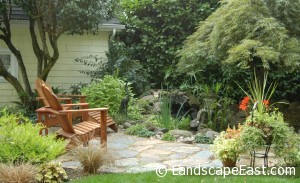 Adding a patio, path, or other hardscaping solution is another route. Why struggle to keep a lawn going when you could create an oasis with a fire pit and/or permeable patio? Shifting away from a lawn may allow you to create more usable space for year-round outdoor living.
Adding a patio, path, or other hardscaping solution is another route. Why struggle to keep a lawn going when you could create an oasis with a fire pit and/or permeable patio? Shifting away from a lawn may allow you to create more usable space for year-round outdoor living.
Our Portland landscaping company can provide a full array of lawn services, from soil testing to design to implementation. Our Portland lawn experts are happy to visit your home and deliver a lawn assessment, complete with recommended solutions for any turf problems. We can go on to carry out any service that many be required—from lawn aeration to designing and digging dry wells. Our expert lawn technicians know how to amend clay-heavy soil to improve growth. And our landscape engineers can design retaining walls, French drains, and even multi-flow systems for draining large expanses. Call us today about any lawn concerns you may have.
 About the Author: Steve Stewart is the Owner/President of Landscape East & West, award-winning Portland landscaping professionals. He oversees the day-to-day operations of the company. Landscape East & West is a leader in the Portland Metropolitan area in creating unique landscape designs and executing expert construction and maintenance with care and pride.
About the Author: Steve Stewart is the Owner/President of Landscape East & West, award-winning Portland landscaping professionals. He oversees the day-to-day operations of the company. Landscape East & West is a leader in the Portland Metropolitan area in creating unique landscape designs and executing expert construction and maintenance with care and pride.
About Landscape East & West: Landscape East & West is a full service Portland landscaping company offering residential landscaping services and full maintenance, irrigation (sprinkler installation, backflow testing, etc.), pruning services, and much more. We also offer a host of design and build services. We invite you to see our award-winning work online. View outdoor kitchens, retaining walls, patios, fire pits and fireplaces, deck and fence designs, garden designs and much more. We are committed to excellence in serving our landscaping customers with outstanding design, implementation and ongoing care that continues to win us awards and happy clients. We serve both individuals and home owners associations.
